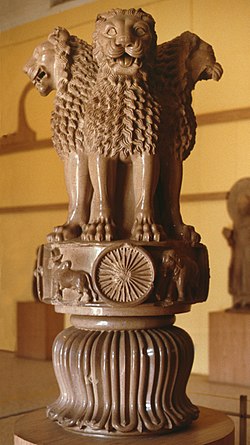| Mauryan polish | |
|---|---|
 The Lion Capital of Ashoka from Sarnath, one of the finest examples of Mauryan polish. | |
| Material | Polished sandstone |
| Period/culture | 3rd Century BCE |
| Place | India. |
Mauryan polish describes one of the frequent characteristics of architecture and sculptures of the Maurya Empire in India (325 to 185 BCE), which gives a very smooth and shiny surface to the stone material, generally of sandstone or granite.[1] Mauryan polish is found especially in the Ashoka Pillars as well as in some constructions like the Barabar Caves. The technique did not end with the empire, but continued to be "used on occasion up to the first or second century A.D.",[2] although the presence of the polish sometimes complicates dating, as with the Didarganj Yakshi. According to the archaeologist John Marshall: the "extraordinary precision and accuracy which characterizes all Mauryan works, and which has never, we venture to say, been surpassed even by the finest workmanship on Athenian buildings".[3]
- ^ The roots of Indian Art, Gupta, p .88
- ^ Harle, 24
- ^ The Early History of India by Vincent A Smith
© MMXXIII Rich X Search. We shall prevail. All rights reserved. Rich X Search
